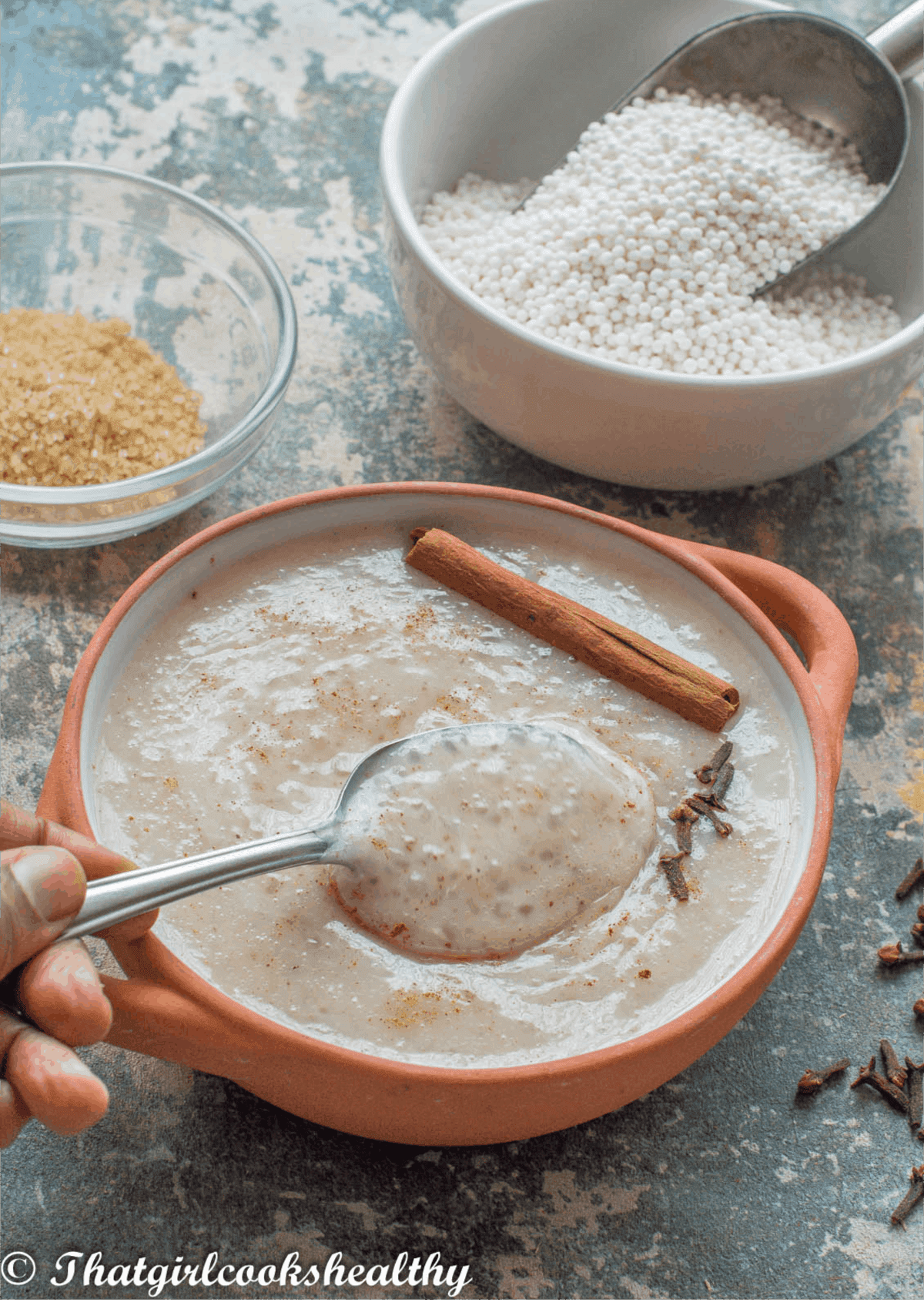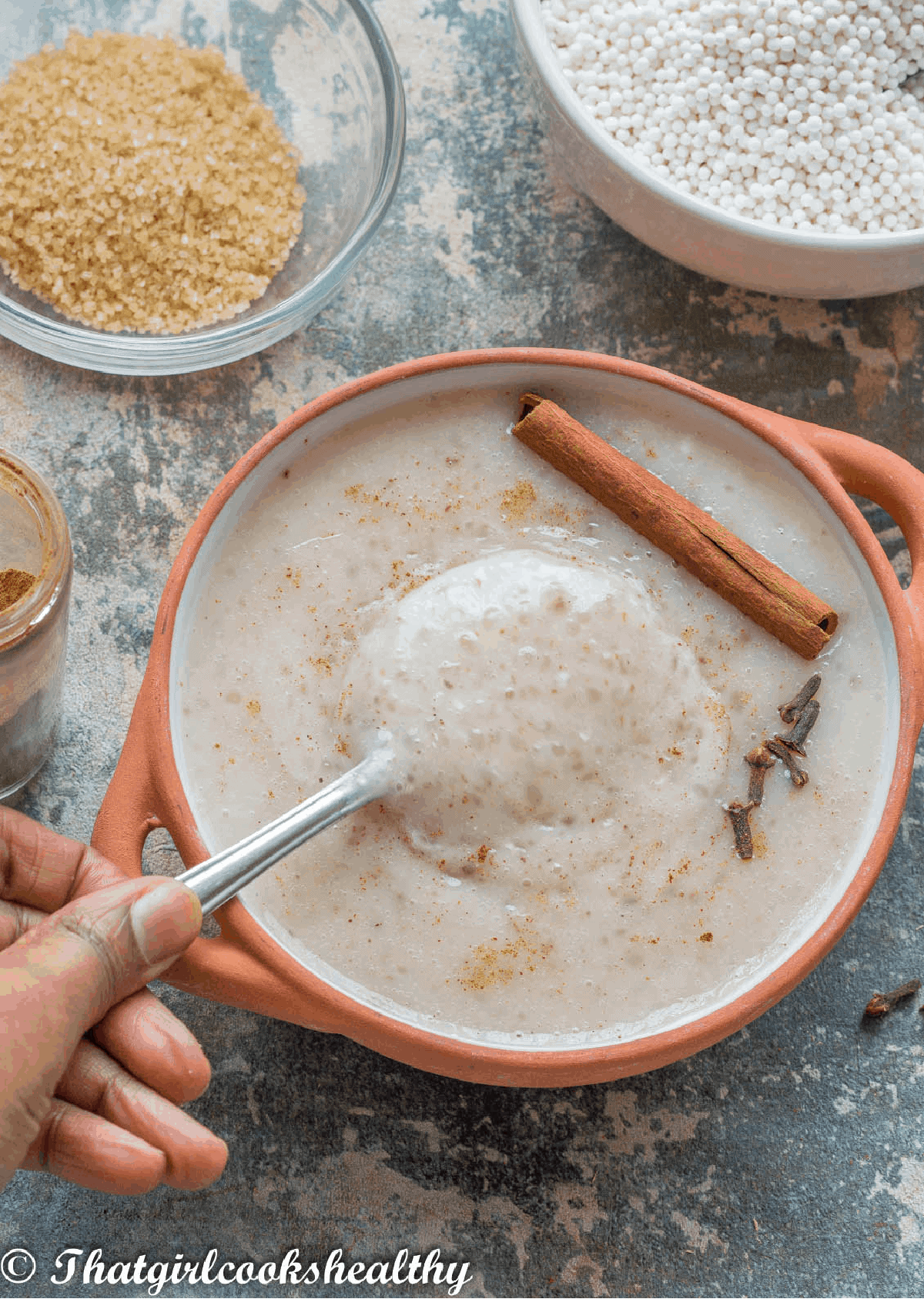Kick start your morning with some Caribbean style sago porridge. This recipe is delicious, filling and totally vegan, free from gluten and ready to serve within 30 minutes.

If you're a big fan of porridge then you will probably enjoy a big bowl of this sago (vegan style) porridge too - warm, hearty, tasty and extremely filling.
Porridge plays a crucial role in the Caribbean culture and is a very important aspect of starting the day. From Crema de Maiz, Labouyi Bannann to hominy corn porridge.
Some porridge coincides with multiple islands i.e cornmeal porridge, while others are unique to that particular island.

What is sago?
Sago is the edible starchy part that is extracted from the pith. The pith is the centre which tends to be quite spongy. It comes from an array of tropical palm plants including the sago palm.
The sago is processed and made into either flour, meal or sago pearls (similar to tapioca pearls).
Many people are under the impression that tapioca and sago are interchangeable when they are both different.
Although similar, the main difference is that tapioca comes from the cassava root vegetable while sago comes from the pith of the sago palm.
While both are very very similar and behave the same however, it is important to note they are two different produce.
Sago is a staple food for regions like Papua New Guinea and the South East Asian countries. It is used as a thickener just like tapioca and is used in desserts, pudding, baking and so fourth.
What is sago porridge?
This porridge is made from the sago pearls, the pearls are typically soaked before being boiled in water along with spices until it thickens.
Once thickened, the milk is stirred in and it is sweetened to taste.
This is a porridge that is more commonly served in Guyana as well as Trinidad and Tobago.
The steps

- Place the sago in a bowl along with the water and soak for about 10 minutes.
- Once the sago has been soaked, strain off and discard the water.
- Add 2 ½ cups of water along with the cinnamon sticks and cloves and the sago to a medium sized non stick saucepan on medium heat.
- Allow the water to heat up all the while continuously stirring so it doesn't stick and begins to thicken like paste (this will take several minutes).
- Immediately add the almond milk then reduce the heat to low and simmer for 5-7 minutes, stirring occasionally.
- During this time add more milk if the sago is too thick, adjust to your preference.
- Finally add the angostura bitters, nutmeg, pink salt and sweeten to taste.
- Discard the cinnamon sticks before serving.
Notes and tips
- Sago is a sticky starchy so be sure to use a NON STICK saucepan.
- Sago is mostly available in stores that are frequented by South East Asians.
- You can also buy it online at places like Amazon.
- Use a sweetener like organic raw sugar cane, coconut sugar, coconut condensed milk or a zero calorie sweeter.
- You can use small white tapioca pearls in place of sago pearls.
- Make your sago with coconut milk for a creamy texture or another plant based milk
- To make your porridge thick, you will want to add the milk slowly until the desired texture is met.
- Use can use dried cinnamon and cloves (¼ tsp) in place of cinnamon sticks/fresh cloves.
- For a thin porridge, once the porridge is ready, add more milk/water.
- Any leftovers should be refrigerated (not frozen) and consumed within 2 days.
- If the porridge has thicken from refrigerating simply add more water/milk when re-heating.

More Caribbean porridge recipes
- Jamaican Oats Porridge
- Hominy Corn Porridge
- Cornmeal Porridge with Hominy Corn
- Cornmeal Porridge
- Yellow Plantain Porridge
- Jamaican Rice Porridge
- Green Banana Porridge
- Peanut Porridge
- Roasted Almond Porridge
**Don't forget to comment below and star rate if you have tried my recipes. Let's be friends and engage on Facebook and Instagram I also like to pin on Pinterest, where you can find more amazing recipes.**

Sago Porridge (Vegan, Gluten Free)
Ingredients
Soaking the sago
- ½ cup sago (118g)
- 2 cups water (475ml)
To make the sago
- 2½ cups water (591ml)
- 2 cups almond milk more if needed (475ml)
- 6 cloves
- ¼ teaspoon nutmeg (1.3g)
- 2 cinnamon sticks
- 1 teaspoon vanilla or angustora bitters (5g)
- ¼ teaspoon pink salt (1.3g)
- sweetener to taste coconut condensed milk, raw cane sugar, coconut sugar, agave nectar etc..
Instructions
- Place the sago in a bowl along with the water and soak for about 10 minutes.
- Once the sago has been soaked, strain off and discard the water.
- Add 2½ cups of water along with the cinnamon sticks and cloves and the sago to a medium sized non stick saucepan on medium heat
- Allow the water to heat up all the while continuously stirring so it doesn't stick and begins to thicken like paste (this will take several minutes).
- Immediately add the almond milk then reduce the heat to low and simmer for 5-7 minutes, stirring occasionally
- During this time add more milk, if the sago is too thick, adjust to your preference.
- Finally add the angostura bitters, nutmeg, pink salt and sweeten to taste
- Discard the cinnamon sticks before serving.
Notes
- Sago is a sticky starchy so be sure to use a NON STICK saucepan.
- Sago is mostly available in stores that are frequented by South East Asians.
- You can also buy it online at places like Amazon.
- Use a sweetener like organic raw sugar cane, coconut sugar, coconut condensed milk or a zero calorie sweeter.
- You can use small white tapioca pearls in place of sago pearls.
- Make your sago with coconut milk for a creamy texture or another plant based milk
- To make your porridge thick, you will want to add the milk slowly until the desired texture is met.
- Use can use dried cinnamon and cloves (¼ tsp) in place of cinnamon sticks/fresh cloves.
- For a thin porridge, once the porridge is ready, add more milk/water.
- Any leftovers should be refrigerated (not frozen) and consumed within 2 days.
- If the porridge has thicken from refrigerating simply add more water/milk when re-heating.




Gina
I've had a sago palm in my front yard before and never knew there was anything edible about the plant! SO intrigued by this recipe, I have to get my hands on some sago to make this porridge!
Charla
Hahaha! It's not as nutritious as tapioca, but it yields a great source of energy. Definitely try it!
veenaazmanov
Delicious, creamy, healthy and nutritious. This Bowl of goodness is perfect for the start of a lovely day.
Charla
Most definitely!
Natalie
I will definitely give this a try. Love having warm porridge during colder days. This sounds very delicious and healthy. Thanks for the recipe!
Charla
You are most welcome Natalie and thank you!
Dannii
This porridge looks so creamy and delicious. I can't wait to try it.
Charla
Thanks Dannii, please do!
Amanda Wren-Grimwood
I love any type of porridge and those flavours are perfect for winter mornings too.
Charla
Thanks Amanda
Crystal
I tried this recipe and it was great. Lovely flavors. I used almost half the amount of almond milk as it would have been too thin for my liking.
Charla
No problem Crystal, I'm glad you liked the porridge and were able to tailor it to the texture that you prefer.